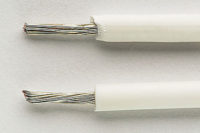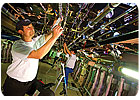
Wire bundles in aircraft are subject to a wide variety of altitude, humidity and vibration extremes. Photo courtesy Labinal
Whether it’s a single-engine airplane, a military helicopter or a commercial jetliner, it’s hard to get airborne without lots of electrical wiring. The aerospace industry is notorious for some of the most challenging applications in the wire processing industry.
Hundreds of wiring harnesses are stuffed into cockpits, engine bays, seatbacks, fuselages and wings. For instance, the Boeing 747 contains more than 135 miles and 4,000 pounds of wire. Its big rival, the Airbus A380, boasts 329 miles of cable, including 100,000 wires and 40,300 connectors.
Wire bundles in aircraft are subject to a wide variety of altitude, humidity and vibration extremes. Wiring must remain absolutely reliable while withstanding extreme forces, high voltages and temperatures ranging from -80 to 260 C.
The insulation on this wire can be tough to strip and often requires special equipment. “Aerospace wire has extremely thin insulation,” says Dave Eubanks, president of Eubanks Engineering Co. “Aerospace companies are always trying to reduce the weight of their products, so they are always looking for ways to reduce the weight of their wire. That is why they continually try to use thinner insulation.”
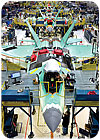
All aircraft wires and cables lead to cockpit instruments. Photo courtesy Lockheed Martin Corp.
Sky-High Market
As last month’s Paris Air Show indicated, the future looks bright for the aerospace market. While business and commercial aircraft orders were affected by the recent recession, aerospace manufacturers expect healthy demand in the decade ahead. China, India and other developing regions are leading the global industry recovery and are expected to capture an increasingly important share of future orders.“Worldwide interest in new-generation technology with improved operating efficiencies, passenger comfort and a reduced environmental impact, paired with expected economic growth in developing markets, will drive the demand for new commercial aircraft,” predicts Guy Hachey, president and CEO of Bombardier Aerospace.
That’s good news for wire harness suppliers. “There can be hundreds of miles of wires and cables throughout an aircraft,” says Chad White, CEO of JKM Manufacturing Inc., which specializes in low-volume, high-mix military applications. “All of the cables in an aircraft eventually lead to the instruments in the cockpit. Those cables are leading to anything from sensors, lights, indicators, transducers, pumps or motors and are attached to either computers or instruments in the cockpit.”
In addition to new aircraft orders, White says he’s seeing more contracts to refurbish aircraft, such as replacing aging wire with more lightweight cables. “There’s a growing need to swap out components, based on the mission,” he points out. “[There’s more demand to make] harnesses more reliable and reduce the overall weight of the plane, making it more fuel efficient.”
Weight and size are important criteria for aerospace wire. “Insulations are kept to the bare minimum in thickness-down to a few times the thickness of a human hair,” says Peter Dickinson, CEO of Spectrum Technologies PLC. “Aerospace requires cable insulations suitable for harsh environments where resistance to chemicals, moisture and mechanical abuse is essential. Also, [wire bundles] need to be durable to last the life of the airframe, which can be more than 30 years.”
“Aerospace wire is typically thinner and lighter in weight than automotive wire,” adds Pete Doyon, vice president of product development at Schleuniger Inc. “The insulation materials used are completely different. For example, Teflon, Tefzel and Kapton are used for aerospace wire insulation, while variations of PVC are used for automotive wire insulation.”
The industry uses a wide variety of wire types with different constructions, including single- or multicore, electrically shielded or unshielded, and round cross section or twisted pair. High-performance insulation materials, such as polytetrafluoroethylene (PTFE) Teflon, ethylene tetrafluoroethylene (ETFE) Tefzel, polyimide Kapton, and combinations of PTFE and polyimide. These materials have varying degrees of hardness and are therefore more difficult to strip with mechanical tools.
Companies such as Judd Wire Inc., a leading supplier of commercial and military aircraft wiring, are using thinner, dual-wall insulations to achieve lower weights and diameters. For example, Judd’s newest hybrid insulation system is the SuperComposite 2000, a combination of dual walls using an enhanced ultra-thin layer of PTFE-polyimide tape with an extruded ETFE copolymer outer layer. Judd claims that this robust combination of materials produces a 0.006-inch dual wall product that can be cut and stripped with all types of manual and automated equipment.
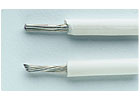
These two identical singlecore wires feature an outside diameter of 3 millimeters. The wire on top has been stripped using a blade, the other with a laser. Photo courtesy Spectrum Technologies PLC
Tight Tolerances
Thin insulations coupled with high quality requirements mean that tolerances are very tight, leaving little margin for error. “Teflon insulation stretches and can leave flags if the stripping blade size is not perfectly matched to the wire,” warns Doyon. “Some of the insulations have multiple layers. If the strip tooling is not perfectly matched to the wire, not all of the layers will be stripped or the conductor strand may be nicked, scraped or broken.”Teflon insulations or multilayer insulations require precision tooling and equipment for a clean strip. “Custom-made die blades or a high-quality rotary stripper are required,” claims Doyon.
“Clean, Class 3 strips are all that is permitted,” says John Williams, southeastern regional sales manager at Komax Corp. “Almost no nicks, dents or scrapes [are acceptable]. In some cases , v-blades may leave too ragged of a strip on Teflon.
“The primary product these customers are looking for is a system to strip the outer jacket on two- and three-conductor convoluted cable,” adds Williams. “This is a very common cable used in almost all aerospace projects. The thin Teflon jacket makes it almost impossible to strip these cables without damaging the braid or conductors. Lasers are expensive and do not always perform reliably on this material.”
Williams says aerospace manufacturers are looking for equipment that sets up reliably and accurately with a minimum of operator intervention. “When trying to process mil-spec Teflon, automatic blade depth [may not be] accurate enough,” he points out.
Aerospace standards for stripping wires are very strict. Damage to the conductor is a big concern. Missing strands on small gauge wires are forbidden, and damage to the insulation is also tightly controlled.
Because lives are at stake, the industry requires precision and accuracy, says Theo Tetteroo, director of processes and tools for emerging markets at Fokker Elmo, which supplies wiring harnesses for leading aerospace companies such as Airbus, Boeing, Bombardier and Lockheed Martin. Manufacturers must adhere to a wide variety of electrical wiring specs, including ASTM F2639, EN2812, MIL-DTL-27500 and SAE-AS 22759.
Thin, multilayer, tape-wrapped insulation makes aerospace wire difficult to strip. Insulations vary from the toughest fiber-reinforced braided power cables to small-diameter, single-core wires. Some wires are electrically shielded with a braided or helical wire mesh screen that lies between layers of polymer insulation. The different materials used in the insulation construction have different physical properties that require different techniques to strip effectively.
“Especially difficult are large diameter braided power cables with fiber reinforcement,” notes Dickinson. “They are traditionally stripped manually with a knife. Shielded, twisted multicore cables need the outer insulation, mesh screen and inner individual layers of insulation removed.”
Some aerospace manufacturers prefer to strip insulation using a laser rather than taking a chance on damaging wires. Spectrum Technologies has developed a line of equipment that’s used by a wide variety of aerospace manufacturers.
“As products become lighter weight, more reliable, more efficient and more cost-effective, conventional methods for stripping wire are becoming increasingly outdated and unacceptable,” claims Dickinson. “Whether it is damage to the wire, the need for constant monitoring of blades to ensure quality standards or the high cost for replacement parts, manufacturers are discovering that they need to find alternatives to these methods.”
According to Dickinson, laser wire stripping features a fast process time, excellent precision and outstanding process control. “Most importantly, laser wire stripping eliminates contact with the wire,” he points out. “And, by using the correct laser type, it is possible to completely eliminate the risk of damage to the conductor or shield.”
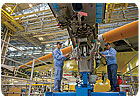
ASSEMBLY ONLINE
For more information on wire processing and aerospace assembly, visit www.assemblymag.com to read these articles:•Wire Processing: The Future of Wire.
•Nanotechnology Will Transform Wire Proc-essing in Aerospace Industry.
•Assembly in Action: Laser Tracking Facilitates Aerospace Assembly.

